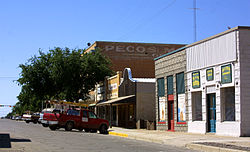Pecos, Texas
| Pecos, Texas | |
|---|---|
| City | |

Storefronts in downtown Pecos
|
|
 Location of Pecos, Texas |
|
 |
|
| Coordinates: 31°24′56″N 103°30′0″W / 31.41556°N 103.50000°WCoordinates: 31°24′56″N 103°30′0″W / 31.41556°N 103.50000°W | |
| Country | United States |
| State | Texas |
| County | Reeves |
| Government | |
| • Mayor | Venetta Seals |
| Area | |
| • Total | 7.3 sq mi (18.9 km2) |
| • Land | 7.3 sq mi (18.9 km2) |
| • Water | 0.0 sq mi (0.0 km2) |
| Elevation | 2,601 ft (793 m) |
| Population (2010) | |
| • Total | 8,780 |
| • Density | 1,200/sq mi (460/km2) |
| Time zone | Central (CST) (UTC-6) |
| • Summer (DST) | CDT (UTC-5) |
| ZIP code | 79772 |
| Area code(s) | 432 |
| FIPS code | 48-56516 |
| GNIS feature ID | 1364996 |
| Website | http://www.pecostx.gov/ |
Pecos (/ˈpeɪkəs/ PAY-kəs) is the largest city in and the county seat of Reeves County, Texas, United States. It is situated in the river valley on the west bank of the Pecos River at the eastern edge of the Chihuahuan Desert and the Trans-Pecos region of west Texas and near the southern border of New Mexico. The population was 8,780 at the 2010 census. The city on January 24, 2012, had just appeared on Forbes 400 as the 2nd fastest-growing small town in the country. The city is a regional commercial center for ranching, oil and gas production and agriculture. The city is most recognized for its association with the local cultivation of cantaloupes. Pecos claims to be the site of the world's first rodeo on July 4, 1883.
Pecos is one of the numerous towns in West Texas organized around a train depot during the construction of the Texas and Pacific Railway. These towns were subsequently linked by the construction of U.S. Highway 80 and Interstate 20. Prior to the arrival of the railroad, a permanent camp existed nearby where cattle drives crossed the Pecos River. With the introduction of irrigation from underground aquifers, the city became a center of commerce for extensive local agricultural production of cotton, onions and cantaloupes. The introduction of large-scale sulfur mining in adjacent Culberson County during the 1960s led to significant economic and population growth. The growth was reversed after mining operations ceased in the 1990s.
...
Wikipedia
